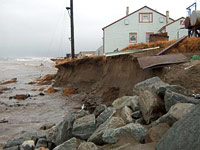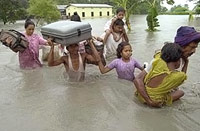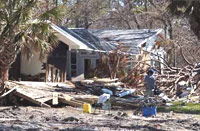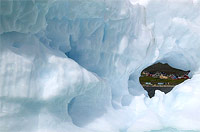The Rising of Our Waters
By Alicia Foss

For years there has been an ongoing debate as to whether or not global warming is occurring. Today, the debate isn't about whether it's happening, but whether it is a crisis we should be worried about. Most scientists agree that global warming is occurring. Now they are trying to figure out what effect global warming will have on mankind.
There is sufficient data to support that the earth is in fact warming. Many scientists believe global warming is having a greater effect on the world than just causing the temperature to increase. Other effects of warming include stronger storms, less precipitation in some areas, warmer winters, and the spread of plants to areas not previously suitable for them to grow in. But one of the more serious and most noticeable effects has been the rising sea level.
Around the world, small island communities have noticed that the sea is rising. Their shorelines are receding and for many of these communities, if the sea rises much more they will be forced to move.
One such community in Shishmaref, Alaska, is already in this situation. There are many factors forcing them to vacate their homes. It goes beyond the rising sea level to deteriorating permafrost and increasingly violent storms (Choo, “Feeling”). Their land is becoming uninhabitable because of rising water, erosion caused by stronger storms, and an increased moistness of the soil due to melting permafrost.

The people of Shishmaref have been in the process of raising money so that they can pick up and relocate. Unfortunately, it is taking longer than expected to raise funds for everyone in the town to relocate together. Tony A.Weyiouanna St., the community leader of Shishmaref, stated, “It was pretty clear that our island was going to wash away and that we needed to relocate” (qtd. in Choo, “Feeling”). This town is in a race against time. Will they raise enough money before the water raises enough for them not to live there?
For now, the people on this small island twenty miles south of the Arctic Circle are safe. The water isn't high enough to force them away yet. They are still able to live on the remaining land. However, in the future, this might not be the case. Glaciers on Greenland and Antarctica hold enough water to raise the sea level several yards. There is evidence that these glaciers are melting faster than normal and adding to the level of the sea.
Previously, scientists believed the main contributor to a rise in sea level was thermal expansion. As water warms it expands. Global warming is the main cause of this expansion. According to NASA's Institute for Space and Studies, thermal expansion has caused the sea level to increase as much as ten inches since pre-industrial time (Choo, “Feeling”).
In other words, over the last 200 years, approximately, the sea has risen about 10 inches. That is a significant amount. However, a 2004 study argued that melting ice is much more important than thermal expansion, probably accounting for two-thirds to three-quarters of sea-level rise in recent decades (Young). If estimates by the Intergovernmental Panel on Climate Change (IPCC) are correct, the sea levels will rise by between 0.09 and 0.88 meters (3.5 and 34 inches) by 2100.
In 2002, Mark Meier and Mark Dyurgerov, both from the Institute of Arctic and Alpine Research at the University of Colorado, estimated that “more than 100 million people live within one meter of mean sea level.” Cities and islands around the world would be in danger. Twenty-one of the world's 33 largest cities would be affected by a sea level rise of one meter, which means over 170 million people would lose their homes (Young).
Cities like Hamburg, London, Miami, New York City and New Orleans would go under water. Bangladesh would lose 17.5 percent of its territory to a one meter rise (Young). Other countries like China, Egypt and Vietnam would be affected, along with coastal regions like Prince Edward Island in Canada and Alaska's island chain. Low lying island nations like the Maldives, Marshall Islands and Kiribati might cease to exist if sea levels rise too sharply (Young).

Bangladesh could be one of the most affected regions if sea rise continues on its expected path. Flooding here could increase as much as 40 percent this century (“Bangladesh”). As it is, Bangladesh already experiences extreme flooding. Much of Bangladesh is just barely above sea level. There are three main rivers in the country and “an increase of just 2 degrees Celsius worldwide would increase flooding in two of the rivers by 20 percent,” according to Monirul Qader Mirza and the Adaption and Research group at the University of Toronto (“Bangladesh”).
Mirza and his team also predict that the amount of land covered by more than 1.8 meters of water over nine months of the year would increase by up to 11 percent. Much of Bangladesh would be in danger and increased flooding could lead to more deaths. There would be a greater opportunity for drowning to occur and the people would have less land to cultivate and grow their crops on.
Not only would the people in these areas be affected by the rising sea, but plant and animal life would be altered as well. As the sea rises, areas that have previously been covered with fresh water would be overrun by salt water.
Animals that live in fresh water would be forced out of their habitats and would have to find new places to live. Plants would have trouble growing. The increased water level would expose their roots to salt, causing many to disappear while others wouldn't flourish like they have.
This increase in salt in the soil also affects many of the crops around the world. For many small island communities, their crops don't grow because the soil is too salty, thus they lose much of their food source (Nicholson). Another major negative effect on plant life would occur with the erosion of the shore line.
The creeping erosion along coastlines also impacts dune life. Jordan Slott and his colleagues at Duke University simulated the effect a two degree Celsius rise in surface temperature and 10 percent wind speed increase would have on erosion. They found “that the waves removed sand from beaches in some regions and re-deposited it elsewhere” (“Rising Seas”).
Erosion doesn't have the same effect everywhere so there could be places that actually increase their shoreline while others lose it. “As coastlines erode, dune plant communities slowly migrate away from the ocean” (“Houses”).
Geographer Douglas J. Sherman and ecologists Rusty A. Feagin and William E. Grant have studied the effects rising sea levels have on dune formation on Galveston Island in the Gulf of Mexico. They have found that plants get trapped “in a small zone, altering the plant population as well as dune structure” (“Houses”). The plant population isn't as large an issue as dune structure. With the increased tension on the dunes, plants are too stressed to grow. This proves to be detrimental to the structure of the dunes because the plants hold them together.

The effects of global warming have already been felt in Louisiana. In 2005, Hurricane Katrina devastated New Orleans. This was one of the most powerful hurricanes ever experienced in the world. Based on climate models, scientists predict that this 500-year storm may be occurring every fifty years by 2100 and 100-year floods may come every ten (Choo, “Heat”). Scientists estimate that “Louisiana is losing 40 square miles of marsh every year” and that “as much as 60 percent of the marsh has disappeared, along with roads and some home sites” between 1950 and 1986 (Schmidt).
One may ask, “Why is the sea rising and are storms becoming more intense?” The answer to this question is still under debate but there is significant evidence suggesting that global warming is the culprit. As the temperatures rise, ice sheets on Greenland and Antarctica melt.
A common belief is that the melting ice burgs at the North and South poles contribute to the rising sea levels; this is false. “Ice burgs don't raise sea levels when they melt because they are floating, which means they have displaced all the water they're ever going to” (Bjerklie, et al.). It's the ice on land, especially Greenland and Antarctica, that contribute to rising sea levels as when the water melts, it is added to the sea, not changing states within the sea. If all the ice on these two continents were to melt, the sea level would rise about 240 feet (Bjerklie, et al.).
This is highly unlikely, but still a scary thought. In 2005, Eric Rignot, a glaciologist with the Jet Propulsion Laboratory in Pasadena, California, and Pannir Kanagaratnam, a research assistant professor at the University of Kansas, have found that Greenland is losing ice twice at fast as it was in 1996, 53 cubic miles compared to only 22 previously (Young). Greenland is emptying enough freshwater into the ocean to supply the city of Los Angeles with fresh water for 53 years (Young).
Antarctica holds even more fresh water than Greenland. Right now, scientists are expecting a gradual one meter rise in sea level over the next 100 years; however, if the West Antarctic Ice Sheet (WAIS) were to collapse, we could expect a five to six meter increase in a matter of decades, or even more quickly (Young).
If this were to happen now, with no further population expansion in coastal cities, over 400 million people would immediately be threatened by the rising sea. Scientists are now looking to predict if this will happen because after the Larsen A ice shelf collapsed in 1995, five of the six glaciers behind it increased their speed to the ocean dramatically, “as if a door stop had been removed or a dam breeched” (Revkin).

Ice sheets in Greenland are increasing their speed towards the ocean as well. Unlike in Antarctica though, a “door jam” hasn't been removed to allow the ice to move faster. In Greenland, the warming air temperature is causing parts of the glacier to melt, and small ponds are formed on the surface. Some of the water from these ponds seeps down through tiny crevices to the base of the glacier where “the water acts as a lubricant, facilitating the slide of glacial ice over the earth below” (Revkin).
The International Panel on Climate Change (IPCC) had predicted an annual rise in sea level of two millimeters; however, from 1995 to 1999, the South Pacific Regional Environment Programme and Australia's Flinders University have found that the Pacific is rising as much as 25mm a year (Nicholson). This significant difference between expected rise and actual rise can be contributed to the fact that the models used and produced aren't the most accurate tools and the data used might not be correct.
Models used to estimate the rate of sea level rise didn't include the Alaskan glaciers. Three Alaskan glaciers, Gulkana, Wolverine and Lemon Creek, have been increasingly deteriorating. “The wastage of these glaciers follows a global trend of accelerated melting since 1988” (Dyurgeroy and Meier).
There are many aspects contributing to the rising sea levels around the world. Glaciers and ice sheets melting in the arctic regions are the main contributors to the rising ocean. Global warming is causing the ice to melt faster, leading to an increase in the speed of the rise of the ocean.
Another side effect of global warming on the ocean is thermal expansion. This too adds to the rising sea level. There are already areas around the world experiencing difficulties due to the rising sea. It's not a problem of the future; it should be looked at now. If we don't find ways to protect our cities, New York and London might disappear. Think about the number of small island nations with a highest elevation one meter above sea level. If the sea keeps rising like expected, these islands could disappear within the next century. Action needs to be taken to protect our cities, marshes and coastlines.
Alicia Foss wrote this piece for her Writing 105 class in fall 2006.
Works Cited
“Bangladesh: The Next Atlantis?” Environment 45.5 (Jun 2003): 8. Academic Search Premier. 9 November 2006. http://search.ebscohost.com
Bjerklie, David, et al. “The Tipping Point.” Time 167.14 (3 Apr 2006): 34-42. Academic Search Premier. 14 November 2006. http://search.ebscohost.com
Choo, Kristin. “Feeling the Heat.” ABA Journal 92 (Jun 2006): 28-35. Environment Complete. 9 November 2006. http://search.ebscohost.com ---. “Heat Wave.” Planning 71.8 (Aug/Sept 2005): 8-13. Academic Search Premier. 9 November 20, 2006. http://search.ebscohost.com
Dyurgeroy, Mark B, and Mark F. Meier. “How Alaska Affects the World.” Science 297.5580 (19 Jul 2002): 350. Academic Search Premier. 14 November 2006. http://search.ebscohost.com
“Houses on the Sand.” Environment 47.9 (Nov 2005): 4. Academic Search Premier. 9 November 2006. http://search.ebscohost.com
“If rising seas don't drown you, they'll wash your home away.” New Scientist 191.2571 (30 Sept 2006): 20. Academic Search Premier. 14 November 2006. http://search.ebscohost.com
Jordan, Stuart. “The Global Warming Crisis.” The Humanist 65.6 (Nov/Dec 2005): 23-29. Academic Search Premier. 14 November 2006. http://search.ebscohost.com
Nicholson, Robert. “Smaller All the Time.” Environment 41.10 (Dec 1999): 9. Academic Search Premier. 9 November 2006. http://search.ebscohost.com
Revkin, Andrew C. “Study of Antarctic Points to Rising Sea Levels.” New York Times 7 Mar. 2003: A8.
Schmidt, William E. “Louisiana's Wetlands Are Steadily Going Out on the Tide.” New York Times 6 Jul. 1986: E5.
Young, John. “Black Water Rising.” World Watch 19.5 (Sept/Oct 2006): 26-31. Academic Search Premier. 14 November 2006. http://search.ebscohost.com


